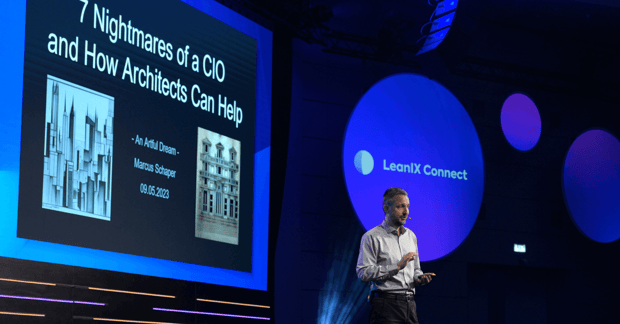
Marcus Schaper recently spoke at our Connect conference on how enterprise architecture can solve the biggest issues CIOs are facing. Let's explore seven CIO "nightmares" and how enterprise architects can help.
Marcus Schaper, former partner at McKinsey and current freelance consultant, gave a keynote speech at our LeanIX Connect summit Europe 2023. He found an innovative way to express how important enterprise architecture (EA) is becoming.
In fact, EA is now a C-level conversation. This is no wonder, as Marcus explained how enterprise architects can solve seven crucial problems CIOs are facing.
Marcus illustrated each of these seven CIO "nightmares" using an artificial intelligence (AI) to create an image in the style of a famous artist. He then asked themore than 130 attendees at our summit if they had the tools and data they needed to solve them. Only 1% of respondents were confident that they could.
Let's explore each of the seven nightmares and explain how the LeanIX platform is the answer for all of them. In the meantime, if you want to watch Marcus' entire presentation, and all the other keynotes from LeanIX Connect, register now:
Watch on-demand
1 - Following The White Rabbit Of Cyber Security

The Nightmare:
The deeper you dig into cyber security, the more you find. Do you know what data your business actually needs to secure?
A mission-critical application might be dependent on a spreadsheet in an outdated system. That data may be protected under regulation, but supplied from a cloud-based application that's reliant on open-source coding, and so on.
Every CIO needs to know the top-ten, mission-critical, crown jewel applications and data centers that their business cannot live without, and what their connections and dependencies are. Each needs to have a clear plan of action in case of a security breach.
The Solution:
Mapping your tech stack with an enterprise architecture management (EAM) tool allows you to see exactly how mission critical each application is. This equates one-to-one with how much you need to invest in cyber security for each area.
You can also gain clarity on which application is dependent on which platform. Likewise, you can find where crucial data is stored and where it feeds to.
On the other hand, value stream management (VSM) tools and software bills of materials (SBOMs) keep a record of where open-source code has been used in your applications. This means you can rapidly take action when a vulnerability is exposed.
Read: How Our VSM Tool Overcame The PyTorch Supply Chain Attack
2 - The Candy Shop Of Tempting Technologies

The Nightmare:
We live in an age where any tool you can imagine is instantly accessible. Your team can now download any application they desire, and even choose among alternative software-as-a-service (SaaS) tools with the same capabilities.
Rather than being supplied with approved software that needs to be set up by IT, employees can now purchase, access, and configure their own tools to their own needs. This may sound risky, but it's actually a great thing.
Each employee can now use whichever tool they find most effective and are no longer relying on extensive IT resource. This is a democratization and decentralization of IT services.
However, the "nightmare" comes in when you realize you have no idea what tools your team is using for what purpose. This means missing out on contract renewals, continuing to pay for software you're not using, the inability to take advantage of economies of scale, and a crippled ability to remove software vulnerabilities.
The Solution:
SaaS discovery tools, like the LeanIX SaaS Management Platform (SMP), allow you to automatically find the SaaS tools in use in your IT landscape, and track and manage their contracts. Empower your team to employ their own SaaS tools, while maintaining oversight of your SaaS portfolio.
3 - Valley Of Despair Of Outdated Technologies

The Nightmare:
We're all excited about the opportunities of artificial intelligence (AI) tools and other innovative services, yet there are zombies lurking in the dark. The greatest opportunities for growth often come from finding the outdated applications in your IT landscape that are either going unused or, worse, holding up your entire organization.
On the one hand, you might find you're continuing to pay for these software 'zombies' when they are no longer needed. Eliminating them can free up resource for innovation and growth.
The real "nightmare", however, is the looming threat that one of these zombie applications is mission critical. Outdated software is subject to security vulnerabilities and prone to failure, so could end up crashing your entire tech stack.
The Solution:
The LeanIX Enterprise Architecture Management (EAM) platform combines automated discovery capabilities with survey generation and collation tools to help you shed light on your entire application portfolio.
Bring all your zombie applications into the light of day, and map every connection you need to sever before retiring them. This not only frees up resource, but also protects your IT landscape against failure.
4 - Sailing The Sea Of Business IT Collaboration

The Nightmare:
IT has traditionally stood apart from the rest of the business, acting as an enabler supplying digital tools without ever getting involved in strategy. Yet, it's a fallacy to even consider "digital tools" anymore, as what business can exist without digital?
Now that all enterprise is digital, IT has a large part to play in every aspect of the business. This means that IT must be closely involved with business strategy and every part of your operations.
Yet, about half of attendees at Marcus' keynote confirmed they knew someone at their organization who refused to collaborate with IT until an issue arose.
The "nightmare" here for CIOs is the frustration of watching projects and initiatives stall because of silos between IT teams and the rest of the business. To be efficient, these siloes need to be broken down.
The Solution:
The key to collaboration between different teams is a shared point of view. Having a single source of truth on your IT estate and inviting feedback and collaboration from the rest of the business builds trust and breaks siloes.
That's exactly what the LeanIX Enterprise Architecture Management (EAM) platform provides. We allow any number of users in your organization to access our platform and view a read-only version of your IT landscape map, so everyone can work together.
5 - Climbing The Mountain Of Transformation

The Nightmare:
Transformation is never straightforward. A now-infamous Boston Consulting Group study found that 70% of digital transformations fail with no return on investment.
That's not even considering the need to go beyond a single re-architecture and transition to a culture of continuous transformation. Understanding all the implications and consequences of a transformation is essential, but complex.
For example, you might understand all the ramifications of a transformation in your own firm, but have you considered how it will impact your partners? Is there regulation that prevents you from storing information in the cloud for a particular region?
The possibilities form another 'nightmare' situation from CIOs.
The Solution:
Once again, the key here is clarity. If you know how your entire tech stack functions and interconnects, then you don't need to be afraid of nasty surprises arising during transformation.
That's why the LeanIX Enterprise Architecture Management (EAM) platform is key for adopting continuous transformation.
6 - High-Speed Sleigh Of Agile Development
The Nightmare:
Agile is all about matching the pace of change in our society, allowing you to adapt to your customers' needs day-by-day. Companies have had to become flexible to survive, but there are always surprises.
Imagine your development pipeline is careening down a mountain slope on a sleigh at high speed. Suddenly, your sleigh hits of patch of ground without snow and you slow to a crawl, losing all momentum to get you down the rest of the mountain.
That patch is the parts of your business that have yet to adapt to Agile and that one weak link in the chain can render all your innovation efforts redundant. The "nightmare" for CIOs is suddenly finding one application that breaks, goes out of date, or just isn't sufficient to ensure agility and innovation.
The Solution:
Enterprise architecture tools not only show your applications, but how they feed into each other and depend on each other, as well as who the users are. They also track contract expirations and application redundancies.
These tools can warn you as soon as an application has a problem that could slow down development. The LeanIX Enterprise Architecture Management (EAM) platform is, therefore, the perfect partner in innovation.
7 - Tears And Joy On The Beach Of People

The Nightmare:
When looking at application portfolio management, it's natural to focus on the applications themselves. Yet, every application has a crucial element that is often forgotten: the user.
- Which roles in your organization will be replaced by AI in the next 24 months?
- Can you upskill those employees now to prevent their redundancy?
- Do your employees have sufficient training to make full use of your application toolset?
- Do they have sufficient training to make full use of the application toolset you will have in a year's time?
- Do your leaders understand your applications well enough to manage the employees using them?
Not being able to answer these questions could lead very quickly to a "nightmare" situation for CIOs.
The Solution:
At LeanIX, we never forget the 'people' angle. Crucial in the process of our Enterprise Architecture Management (EAM) platform is automated user surveys for process mining.
This allows our platform to discover and record the feedback of users on their platforms. This offers clarity on where training, development, and change management is needed.




